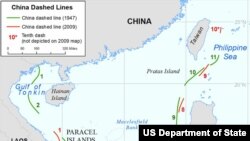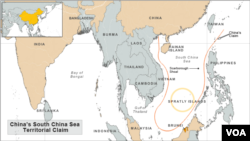China rejected a U.S. government report detailing Beijing's maritime territorial claims in the South China Sea, saying the document violates Washington's pledge to remain neutral in the dispute.
Both Beijing and Washington released reports in the past week that weighed-in on the longstanding dispute over who owns the scores of reefs, small islands and surrounding waters of the resource rich South China Seas.
A U.S. State Department report examined the historic, geographic and legal basis for China’s vast claims in the strategic region, concluding that they do not accord with the international law of the sea, based on the U.N. treaty that China has signed.
That drew a sharp response from China’s foreign ministry.
Watch report by VOA State Department correspondent Scott Stearns
US to take no sides
Spokesperson Hong Lei said China’s rights and claims in the sea are formed by history and upheld by Chinese governments. Hong said the U.S. report violates its commitment of taking no sides in the South China Sea issue.
China’s territorial claims in the South China Sea are outlined in maps containing the so-called nine-dash line, a boundary that encloses water, islands and other features of the resource-rich sea.
This includes territory that has long been claimed by other nations, including Vietnam and the Philippines.
The Philippines has appealed for international arbitration in the dispute under the U.N. Convention on the Law of the Sea (UNCLOS).
China has until December 15 to defend its position, but Beijing has already signaled that it will not participate in the process.
In a government report published Sunday, Beijing made the case that the territorial disputes must first be worked out between the nations before any international arbitration can move forward.
China has long rejected having the United Nations or other international body help adjudicate the dispute, preferring to deal with the disagreements one-on-one with other nations.
The study by the U.S. State Department’s Bureau of Oceans and International Environment and Scientific Affairs (OES), said China, in backing its claim, is using maps that date back to 1947, but the maps “lack precision” and are too inconsistent to form as the basis for its historical claim to the waterway.
The study also said there is no “Chinese law, declaration, proclamation or other official statement describing and putting the international community on notice of a historical claim to the waters within the dashed line.”
It said that China’s historical claim fails to meet the legal tests used in international law for addressing these kinds of disputes.
Carl Thayer, a professor at the Australian Defense Force Academy, said while the Chinese paper seeks to influence judges in the arbitration case without direct engagement, the U.S. study presses China forcefully for clarification on its territorial claims.
“China can take out lines, they can add them as they have, around Taiwan, the 10th line,” Thayer said. “So these lines are not as fixed as China would like us to believe. So the U.S. has set the ball rolling in helping push the legal argument further.”
Maritime zones agreed upon
The U.S. study also said that China’s claims are contrary to the provisions on maritime zones of UNCLOS, which were accepted by China as a signatory to the convention. Those provisions favor sovereign rights of a coastal state over historical claims.
It concluded that China cannot use the nine-dash line to unilaterally establish maritime boundaries with other countries and that China needs to “clarify its claim.”
Wang Dong, a professor of international relations at Peking University, said the U.S. paper and the Philippines’ initiation of arbitration is not constructive to resolving the dispute.
“It’s not helpful in calming things down in the South China Sea,” Wang said. “It might stir, unnecessarily, things up and embolden some of the claimant countries to not engage in negotiation on good faith and instead try and take a confrontational approach towards this issue.”
The South China Sea is contested by several nations. It is one of the busiest shipping lanes in the world and rich in potential minerals, oil and gas resources.
China said the outcome of the arbitration case will not “shake China’s resolve and determination to safeguard its sovereignty and relevant maritime rights and interests.”

















